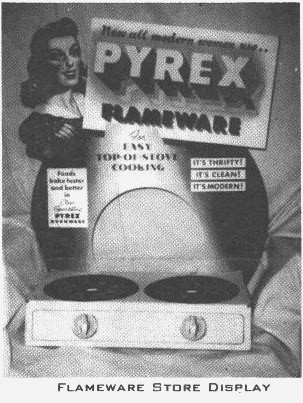National Depression Glass Association
Preserving America's Glass Manufacturing Heritage
Pyrex Flameware
by Leonette A. Walls, Ed. D.
Flameware by Pyrex by Coming Glass Works of Corning, New York is a line of range top kitchenware that often is overlooked. Recently, more items are being seen at shows and malls, creating a new area of collector interest. Not only are many pieces attractive, the line is one of practicality in the kitchen.
Flameware was a different type of glass composition from the
regular Pyrex. The blue tint was designed to distinguish it from
clear Pyrex items. The earlier pieces went into production around
1936. Flameware was produced at two locations in Corning at
 different time intervals, with the bulk of production at Main Plant
"B." About the same period of time, Anchor Hocking's Sapphire blue
cookware were produced. The color of the early Flameware was
considerably darker than the Anchor Hocking blue,with the Anchor
Hocking line probably having more collectors. Part of the
difference in popularity may be due to the decorations in the molds
of Sapphire Blue.
different time intervals, with the bulk of production at Main Plant
"B." About the same period of time, Anchor Hocking's Sapphire blue
cookware were produced. The color of the early Flameware was
considerably darker than the Anchor Hocking blue,with the Anchor
Hocking line probably having more collectors. Part of the
difference in popularity may be due to the decorations in the molds
of Sapphire Blue.
Identification of Flameware is easy as most pieces were imprinted in the bottom of each piece with the "flame" logo, plus the item number and size. The design of the logo can be used to help determine the time frame of production. Also the "flame" can be seen on the metal bands around coffee and tea pots and other banded items. On many items, the mold number is displayed as well.
Selling points for the homemaker was the reduced amount of fuel needed to cook, plus the advantage of being able to see the food as it cooked. Additionally, it could be used, not only for cooking, but for storage.
The color of Flameware was changed to an almost clear one with a hint of blue on the bottom after the war, about 1946. This suggestion by the director of the Home Economics Department and Test Kitchen thought the lighter color to be mere appealing to homemakers.
Another feature of the Flameware series was the detachable handle for a number of the skillets and saucepans. There were several styles of handles. These pieces were also sold with or without lids.
Other items included tea kettles, coffee percolators with glass baskets and center post, and double boilers with detachable bands with varying style handles during the years of production of Flameware through 1979. The later versions show more modernistic designs with subtle changes in handles and lids.
More in-depth information is available in Pyrex By Corning (A Collectors Guide) by Susan Tobier Rogove and Marcia Buan Steinhauer. This work not only gives identification and price guides for an extensive listing of Pyrex products, but gives excellent historical data. This background information gives the collector a greater understanding of the products and the changes that occurred through the lengthy production. Photographs with identifying numbers make identification quite easy. The inclusion of an index makes the book user-friendly.
There seems to be increased interest in Pyrex; some for its collectibility and other purchases for practical use. Flameware certainly has had a significant role in the life of the American homemaker; only time will tell how collectible these kitchen wares will be.
Webmaster's Note: This article was taken from the publication "Glass and More, May 1999" with permission from the publisher, Dr. Leonette Walls.